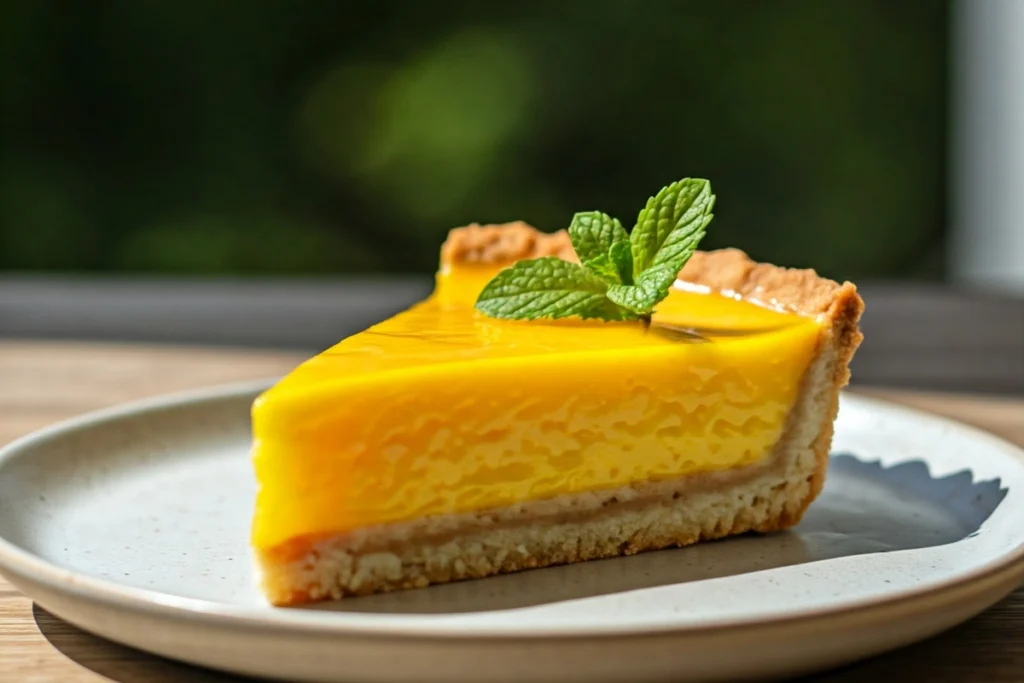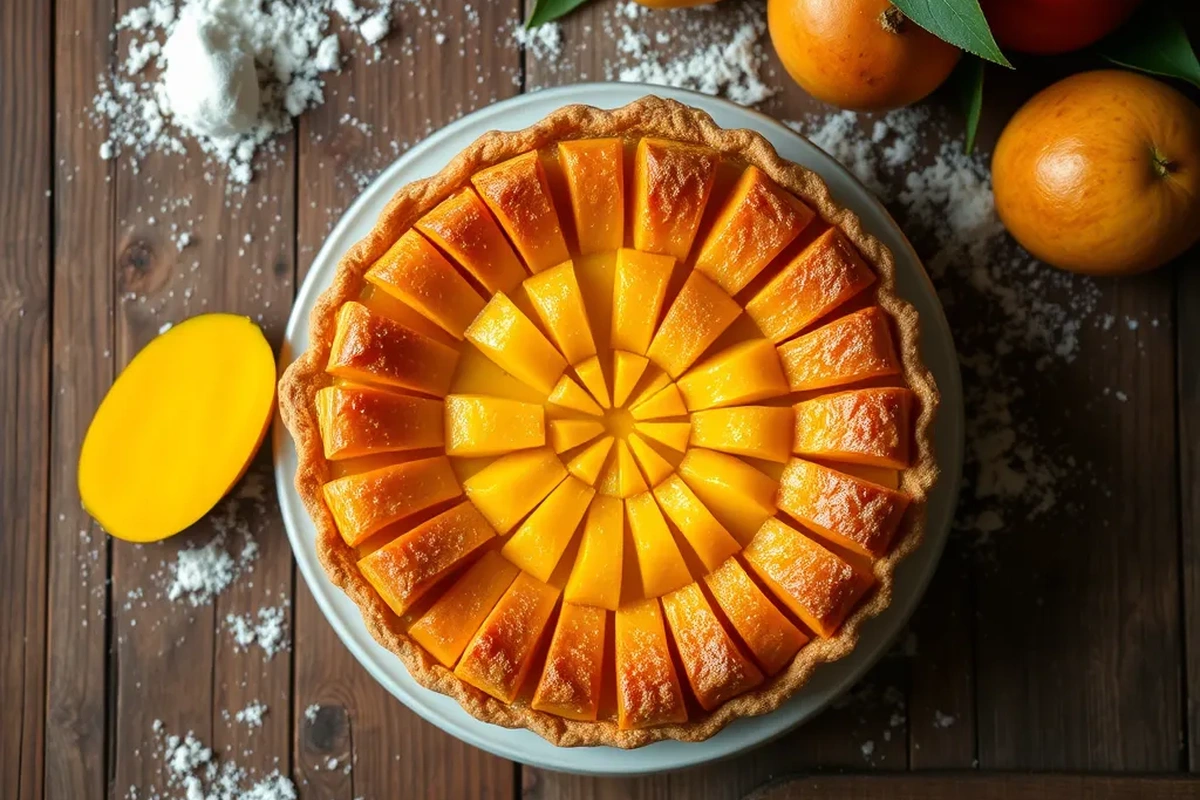Bursting with tropical flavor, this luscious dessert transforms fresh mangoes into a sweet and creamy delight perfect for any occasion.
The Tempting Allure of This Tropical Dessert
Mangoes have a special place in many cultures worldwide. They possess a naturally sweet taste and velvety texture. In the United States, many households cherish the delightful treat known as mango pie. This dessert stands out because it brings bright color and tangy-sweet flavor to your dining table. Furthermore, it pairs well with various toppings, such as whipped cream or toasted coconut. Whether for a festive occasion or a casual gathering, this tropical dessert can easily become the star of any menu.
The Origin of Mango Pie
The origins of mango pie trace back to creative bakers seeking new ways to showcase seasonal fruit. Mangoes, originally grown in South Asia, spread across the globe, eventually reaching the Caribbean and the Americas. Accordingly, cooks experimented with local produce, discovering that the luscious taste of mango blended perfectly with pie fillings. Over time, families in tropical regions started incorporating mango variations into classic pastries. Eventually, these sweet innovations found their way to American kitchens, where they became beloved summertime desserts.
Key Ingredients for Mango Pie
Creating the perfect mango pie involves selecting fresh mangoes, a flaky crust, and the right sweetener. Because mangoes come in diverse varieties, it is crucial to choose ripe fruit with vibrant flesh. Consequently, Alphonso and Ataulfo mangoes often deliver the best results thanks to their sweetness. Additionally, use good-quality butter or shortening for the crust, ensuring a tender texture. A dash of lemon juice helps balance the sweetness, adding a subtle tang to each bite.
For the filling, consider blending fresh chunks with a bit of cornstarch or tapioca flour. This thickens the mixture and prevents a soggy crust. Moreover, some bakers prefer adding a hint of spice, like cinnamon or cardamom, to enhance the flavor profile. Others incorporate coconut milk for a tropical twist. Regardless of your preference, the focus remains on highlighting the rich taste of ripe mango, making the pie irresistibly inviting.
How to Prepare the Crust
Initially, gather all your crust ingredients, including flour, cold butter, sugar, and salt. Cut the butter into small cubes and combine it with the flour mixture, ensuring a crumbly consistency. Next, add cold water, one tablespoon at a time, until the dough barely holds together. Consequently, form the dough into a disk, wrap it in plastic, and chill it for at least an hour. Chilling helps the gluten relax, resulting in a flaky, tender base for your tropical creation.
The Best Crust for Mango Pie
Choosing the right crust for mango pie can drastically impact your dessert’s texture. Some prefer a traditional pastry crust, while others opt for a graham cracker shell. The latter adds a crunchy contrast to the soft mango filling. However, if you crave a buttery, tender bite, stick with classic pie dough. Whichever route you take, blind-baking the crust for a few minutes ensures a crisp foundation for your vibrant filling.
Assembling the Pie
After chilling the dough, roll it out on a floured surface until it is about one-eighth of an inch thick. Carefully transfer it to your pie dish, trimming any excess around the edges. Then, combine your mango filling ingredients, such as diced mango, sugar, and thickener. Pour this mixture into the prepared crust, spreading it evenly. Alternatively, you can arrange mango slices in a decorative pattern. Finally, if you prefer a top crust, gently place it over the filling and crimp the edges.
Tips for Perfectly Slicing Mangoes for Mango Pie
Preparing mango slices for mango pie can be tricky. Initially, wash your mangoes thoroughly to remove any debris. Next, use a sharp knife to slice off each cheek, avoiding the pit. Carefully score the flesh into even strips, then invert the skin to separate the slices. Because mango can be slippery, work slowly and keep your fingers clear of the blade. Altogether, these steps ensure neatly sliced fruit that looks appealing in your finished dessert.
Baking Instructions
Before placing your pie in the oven, preheat it to 375°F. This temperature fosters even baking and golden crust. Then, bake for 35 to 45 minutes, or until the crust achieves a light golden hue. If you notice the edges browning too quickly, tent them with foil to prevent burning. Particularly for a lattice or open-top pie, watch for the filling to bubble gently. Once done, allow the pie to cool slightly so the filling sets.
Serving Suggestions for Mango Pie
Serving mango pie fresh from the oven offers the best taste. Nonetheless, letting it rest for 15 minutes allows the filling to firm up. Subsequently, garnish each slice with a dollop of whipped cream or a scoop of vanilla ice cream. Another popular choice is drizzling caramel or chocolate sauce on top. Comparatively, a sprinkling of toasted coconut adds a crunchy dimension. Indeed, these toppings complement the tangy-sweet mango flavor beautifully.

How to Store Your Mango Pie
Storing mango pie properly preserves freshness and ensures you can enjoy leftovers. Ideally, keep your baked pie covered at room temperature for up to two days. If you live in a warmer climate, refrigeration becomes necessary to prevent spoilage. Consequently, wrap the pie in plastic or foil before placing it in the fridge. It will stay fresh for about four days. While chilled, the filling may firm up further, so let each slice warm slightly before serving to recapture that tropical charm.
Freezing and Reheating
If you want to keep your dessert for a later date, freezing is a practical solution. First, allow the baked pie to cool entirely. Then, wrap it tightly in plastic wrap and a layer of aluminum foil. This dual protection safeguards the crust from absorbing unwanted odors. When you are ready to enjoy it, thaw the pie in the refrigerator overnight. Afterward, you can warm individual slices in the oven at 300°F for about 10 minutes, revitalizing its fresh-baked essence.
Popular Variations
Variations of this dessert showcase different cultural twists. One popular style features a coconut cream layer spread on top of the mango filling. Another approach involves blending cream cheese for a rich, tangy flavor. Comparatively, some bakers add a streusel topping with oats and brown sugar. This crumbly layer introduces extra texture and sweetness. Equally, you can experiment with additional fruits such as strawberries or peaches. Altogether, these adaptations give home cooks endless avenues to personalize their own pies.
Healthier Alternatives
For health-conscious bakers, there are ways to reduce the sugar and fat content without sacrificing flavor. Firstly, consider using a whole-wheat crust or almond flour crust. Consequently, you boost the fiber and protein while lowering refined carbs. Secondly, replace some of the sugar with naturally sweet pureed mango or a small amount of honey. Furthermore, use Greek yogurt instead of heavy cream for a lighter filling. Altogether, these substitutions help create a dessert that is both delicious and nutritious.
Expert Baking Tips
Baking can sometimes feel intimidating. However, a few pointers simplify the process. Always taste your mangoes before using them to gauge sweetness. Consequently, you can adjust the sugar levels. In addition, chilling the dough thoroughly helps the crust maintain its structure during baking. Meanwhile, consider partially cooking your mango filling on the stovetop if you prefer a smoother consistency. Ultimately, small steps like these boost your confidence and yield a perfectly baked, mouthwatering pie every time.
Common Mistakes to Avoid
One frequent issue is selecting mangoes that are too firm or under-ripe. Consequently, the filling may lack the desired sweetness and tenderness. Another error involves overmixing the dough, resulting in a tough crust. Furthermore, failing to blind-bake the bottom crust can cause sogginess. Equally, adding too much liquid to the filling leads to runny slices. Finally, removing the pie from the oven too soon creates a flimsy structure. By avoiding these pitfalls, you elevate your mango pie to professional standards.
Pairing Beverages with This Tropical Treat
Picking the right beverage enhances the overall flavor experience. Chiefly, fruit-infused iced tea with a hint of lemon complements the dessert’s sweetness. Conversely, a creamy coconut milkshake underscores the tropical vibe. Particularly in warmer months, a refreshing mint lemonade balances the richness of mango pie. Meanwhile, coffee lovers might enjoy a light roast coffee or a frothy cappuccino. Ultimately, these pairings round out your meal, making every mouthful truly memorable.

Cultural Significance
Mango-based desserts hold a special place in many tropical cuisines. Indeed, numerous celebrations feature sweet treats that highlight ripe fruit. Because mango is often viewed as a symbol of abundance and good fortune, serving mango pie can impart positive energy to festive occasions. Moreover, in places like Florida or Hawaii, local farmers’ markets thrive with fresh mangoes at peak season. Hence, locals embrace pies and pastries that celebrate their regional produce. Such traditions foster community and culinary innovation alike.
Final Thoughts
Mango pie offers a vibrant, fruity twist on a classic dessert. Undoubtedly, it brings sunshine and sweetness to any table setting. Particularly in warm weather, its tangy flavor stands out as a refreshing treat. Meanwhile, the adaptability of the recipe invites countless variations. Whether you opt for a simple, rustic approach or an elaborate lattice design, the essence of this dessert remains the same. In the end, nothing compares to the delightful aroma and tropical taste of a freshly baked mango pie.
Hosting a gathering becomes easier when you have an impressive dessert ready. Mango pie stands out not only for its taste but also its vibrant hue. Because many guests appreciate fruity treats, this pie often draws compliments from those who crave a refreshing finish. Additionally, you can prepare parts of it in advance, saving time on the day of the event. Consequently, focusing on the final touches ensures a stress-free presentation. Expect rave reviews after every delightful slice.
Trying new recipes at home fosters creativity and culinary skills. Indeed, mango pie can be the stepping-stone toward mastering fruit desserts. Because the filling relies on fresh produce, home bakers gain an appreciation for seasonal flavors. Additionally, exploring alternative crusts or garnishes keeps the process exciting. If you feel adventurous, experiment with different spices or sweeteners. Eventually, you may discover a signature version that becomes your household favorite. Such a personal touch leaves a lasting impression on family and friends.
For anyone seeking an eye-catching finale to a special meal, mango pie stands as a top contender. Because of its golden color and tropical flair, it instantly evokes a sense of summer bliss. Nonetheless, it can also brighten colder days by recalling sunny climates. Consequently, this dessert transcends seasons and satisfies diverse palates. Pair it with a crisp white wine for an elegant dinner party, or enjoy it after a casual barbecue. Regardless of the setting, you are sure to impress with this radiant delight.
Frequently Asked Questions
1) Can I use frozen mango in mango pie?
Yes, you can. However, thaw the fruit beforehand and drain any excess liquid. Otherwise, the filling may become too watery. Consequently, if you notice too much moisture, add a spoonful of cornstarch for extra thickening. Nonetheless, fresh mango often gives a sweeter, more vibrant taste overall.
2) How do I prevent a soggy crust?
Blind-bake the crust for about 10 minutes at 375°F. Moreover, ensure your filling is not overly liquid. Particularly, you can sprinkle a thin layer of breadcrumbs or crushed cookies on the crust before adding the mango mixture. Accordingly, this barrier absorbs excess moisture and preserves a crisp foundation.
3) Should I add spices to my mango pie?
Spices are optional, but they can elevate the flavor. For example, a pinch of cinnamon or cardamom imparts warm undertones. Likewise, a dash of nutmeg complements the natural sweetness of mango. However, avoid adding too many spices, or they may overshadow the fruit’s delicate taste.
4) Can I make a vegan version of mango pie?
Absolutely. Chiefly, use vegan butter or coconut oil in the crust. Additionally, replace dairy-based ingredients with almond milk or coconut cream. Consequently, the pie remains creamy and flavorful. Be sure to check that all sugar and other components meet vegan standards. Undoubtedly, the result will be a cruelty-free, delicious dessert.
Ultimately, there are endless ways to customize this tropical treat.

